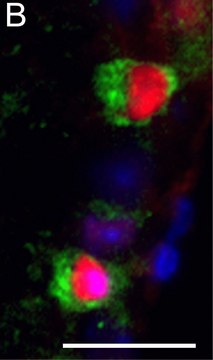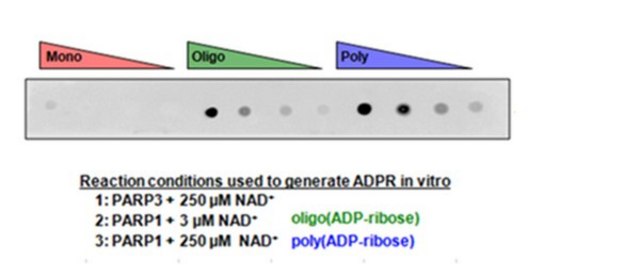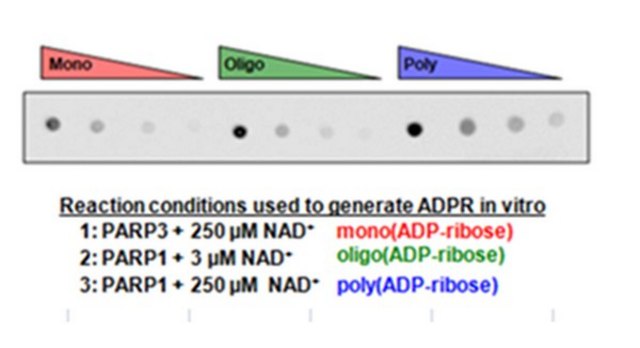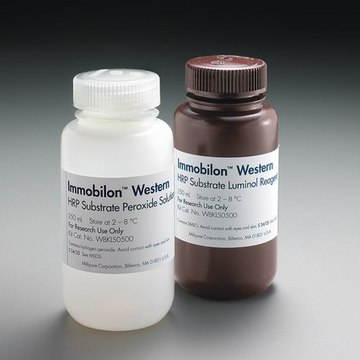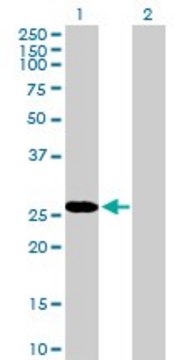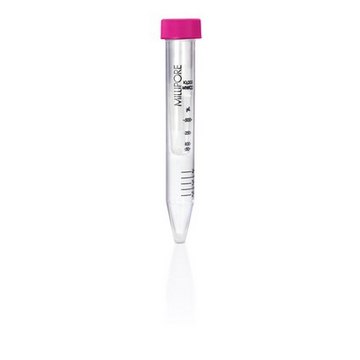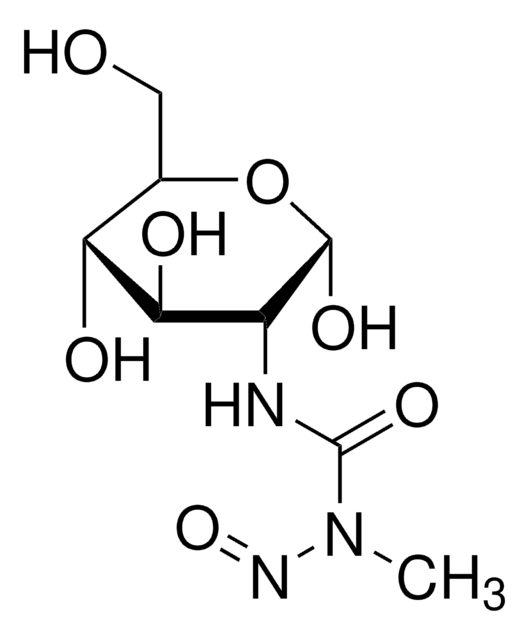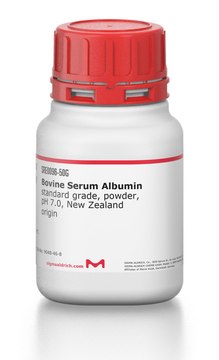ABN1376
Anti-RBPMS Antibody
from guinea pig, purified by affinity chromatography
Sign Into View Organizational & Contract Pricing
All Photos(2)
Synonym(s):
RNA-binding protein with multiple splicing, RBPMS, RBP-MS, Heart and RRM expressed sequence, Hermes
UNSPSC Code:
12352203
eCl@ss:
32160702
Recommended Products
biological source
guinea pig
antibody form
affinity isolated antibody
antibody product type
primary antibodies
clone
polyclonal
purified by
affinity chromatography
species reactivity
human, rat, mouse, guinea pig, monkey, rabbit
technique(s)
immunofluorescence: suitable
western blot: suitable
NCBI accession no.
UniProt accession no.
shipped in
wet ice
target post-translational modification
unmodified
Gene Information
human ... RBPMS(11030)
General description
RNA-binding protein with multiple splicing (UniProt Q93062; also known as Heart and RRM expressed sequence, Hermes, RBP-MS) is encoded by the RBPMS (also known as HERMES) gene (Gene ID 11030) in human. RBPMS is a member of the RRM (RNA recognition motif) family of RNA-binding proteins. Transcriptome-wide study using photoactivatable-ribonucleoside-enhanced crosslinking and immunoprecipitation (PAR-CLIP) in HEK293 cells reveals both exonic mature and intronic pre-mRNA-binding sites, in agreement with the nuclear and cytoplasmic localization of the RRM family proteins. RBPMS is found to be exclusively expressed in retinal ganglion cells (RGCs) and displaced RGCs (dRGCs). RBPMS expression can therefore be utitized as a RGC marker, and the RBPMS gene promoter could be utilized for driving RGC-specific transgene expression.
Specificity
Expected to react with all five spliced isoforms (UniProt Q93062-1 through Q93062-5).
Immunogen
Epitope: N-terminal region
KLH-conjugated linear peptide corresponding to a sequence from the N-terminal region of human RBPMS.
Application
Anti-RBPMS Antibody is an antibody against RBPMS for use in Western Blotting, Immunofluorescence.
Research Category
Neuroscience
Neuroscience
Research Sub Category
Sensory & PNS
Sensory & PNS
Western Blotting Analysis: A representative lot detected endogenous RBPMS in mouse and rat retina extracts, as well as exogenously expressed human RBPMS in transfected HEK293T cells (Rodriguez, A.R., et al. (2014). J. Comp. Neurol. 522(6):1411-1443).
Immunofluorescence Analysis: A representative lot detected RBPMS immunoreactivity primarily associated with cell bodies located in the ganglion cell layer (GCL) of paraformaldehyde-fixed mouse retinas by fluorescent immunohistochemistry using whole-mounted retinas (Rodriguez, A.R., et al. (2014). J. Comp. Neurol. 522(6):1411-1443).
Immunofluorescence Analysis: An 1:5,000 dilution of a representative lot detected RBPMS immunoreactivity among cells in the ganglion cell layer (GCL) of paraformaldehyde-fixed mouse retinas by fluorescent immunohistochemistry (Courtesy of Dr. Nicholas Brecha, David Geffen School of Medicine at UCLA).
Immunofluorescence Analysis: A representative lot detected RBPMS immunoreactivity primarily associated with cell bodies located in the ganglion cell layer (GCL) of paraformaldehyde-fixed mouse retinas by fluorescent immunohistochemistry using whole-mounted retinas (Rodriguez, A.R., et al. (2014). J. Comp. Neurol. 522(6):1411-1443).
Immunofluorescence Analysis: An 1:5,000 dilution of a representative lot detected RBPMS immunoreactivity among cells in the ganglion cell layer (GCL) of paraformaldehyde-fixed mouse retinas by fluorescent immunohistochemistry (Courtesy of Dr. Nicholas Brecha, David Geffen School of Medicine at UCLA).
Quality
Evaluated by Western Blotting in mouse embryonic stem cell (mESC) lysate.
Western Blotting Analysis: 2.0 µg/mL of this antibody detected RBPMS in 10 µg of mouse embryonic stem cell (mESC) lysate.
Western Blotting Analysis: 2.0 µg/mL of this antibody detected RBPMS in 10 µg of mouse embryonic stem cell (mESC) lysate.
Target description
~25 kDa observed
Physical form
Affinity purified
Purified guinea pig polyclonal antibody in PBS with 1 % BSA and 0.09% sodium azide.
Storage and Stability
Stable for 1 year at 2-8°C from date of receipt.
Other Notes
Concentration: Please refer to lot specific datasheet.
Disclaimer
Unless otherwise stated in our catalog or other company documentation accompanying the product(s), our products are intended for research use only and are not to be used for any other purpose, which includes but is not limited to, unauthorized commercial uses, in vitro diagnostic uses, ex vivo or in vivo therapeutic uses or any type of consumption or application to humans or animals.
recommended
Product No.
Description
Pricing
WGK
WGK 2
Flash Point(F)
Not applicable
Flash Point(C)
Not applicable
Regulatory Information
新产品
Certificates of Analysis (COA)
Search for Certificates of Analysis (COA) by entering the products Lot/Batch Number. Lot and Batch Numbers can be found on a product’s label following the words ‘Lot’ or ‘Batch’.
Already Own This Product?
Find documentation for the products that you have recently purchased in the Document Library.
Yadan Quan et al.
Experimental and therapeutic medicine, 19(1), 619-629 (2019-12-31)
Leucine-rich repeat and immunoglobulin-like domain-containing nogo receptor-interacting protein 1 (lingo-1) is selectively expressed on neurons and oligodendrocytes in the central nervous system and acts as a negative regulator in neural repair, implying a potential role in optic neuropathy. The aim
Jacob K Sterling et al.
Cell reports, 33(5), 108271-108271 (2020-11-05)
Glaucoma is the leading cause of irreversible blindness and is characterized by the death of retinal ganglion cells (RGCs). Recent studies have implicated pro-inflammatory microglia, macrophages, and A1 astrocytes in the pathogenesis of neurodegenerative diseases. The role of pro-inflammatory, neurotoxic
Wolfgang Pita-Thomas et al.
Scientific reports, 11(1), 14924-14924 (2021-07-23)
Retinal Ganglion Cells (RGCs) lose their ability to grow axons during development. Adult RGCs thus fail to regenerate their axons after injury, leading to vision loss. To uncover mechanisms that promote regeneration of RGC axons, we identified transcription factors (TF)
Sally L Baxter et al.
Scientific reports, 10(1), 19013-19013 (2020-11-06)
Glaucoma disproportionately affects individuals of African descent. Prior studies of the PIEZO1 mechanoreceptor have suggested a possible role in glaucoma pathophysiology. Here, we investigated associations between a Piezo1 gain-of-function variant common in individuals of African descent with glaucoma-related phenotypes. We
Ying Li et al.
Frontiers in genetics, 9, 633-633 (2019-01-09)
Purpose: The present study examines the role of Sox11 in the initial response of retinal ganglion cells (RGCs) to axon damage and in optic nerve regeneration in mouse. Methods: Markers of retinal injury were identified using the normal retina database
Our team of scientists has experience in all areas of research including Life Science, Material Science, Chemical Synthesis, Chromatography, Analytical and many others.
Contact Technical Service
